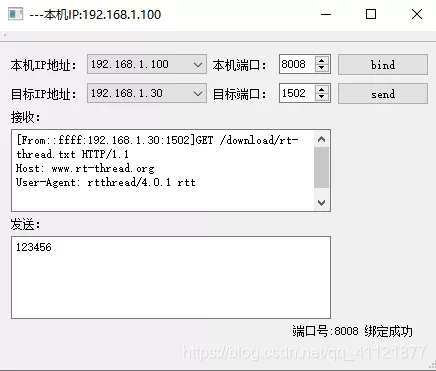QT5实现UDP通信的示例代码
前言
一、UDP通信概述
二、UDP单播模式
1.接收数据
2.发送数据
总结
代码h文件
代码c文件
该例程经过实际验证可以正常使用,只简单的使用UDP中的单播模式(一对一),其余模式将在后期逐步说明。。。。。。
所用测试系统在同一局域网,其中:
QT版本:5.12
PC端UDP模式:单播
UDP通信目标:基于STM32F4+LWIP协议的以太网接口
UDP是轻量的、不可靠的、面向数据报、无连接的协议,它可以用于对可靠性要求不高的场合,和TCP通信不同,两个程序之间进行UDP通信无需预先建立持久的socket连接,UDP每次发送数据报都需要指定目标地址和端口。
QUdpSocket类用于实现UDP通信。发送数据报使用writeDatagram()函数,数据报的长度一般小于512字节,每个数据报包含发送者和接收者的IP地址和端口等信息;接收数据报要先用bind()函数绑定一个端口,当有数据传入时会触发readyRead信号,使用readDatagram()函数来读取接收到的数据。

本文实现的是上位机(PC)向下位机(STM32)发送信息,STM32接收到信息之后回立刻返回一帧信息,上位机接收到信息之后,解析命令得到下位机的IP地址和端口号,并同信息内容一同打印。
先在QT的.pro文件中添加QT += network。
要实现UDP数据的接收,必须先用bind()函数绑定本机的一个端口,用于监听传入的数据报,解除绑定则使用abort()函数。绑定端口之后,当上位机接收到数据就会触发QUdpSocket类中的readyRead()信号,因此将该信号通过槽函数连接到UDPSocketReadyRead()函数处理接收到的数据。
/*
* 接收数据
*/
void MainWindow::UDPSocketReadyRead()
{
while(Myudpsocket->hasPendingDatagrams())
{
QByteArray Recivedata;
Recivedata.resize(Myudpsocket->pendingDatagramSize());
QHostAddress peerAddr;
quint16 peerPort;
Myudpsocket->readDatagram(Recivedata.data(), Recivedata.size(), &peerAddr, &peerPort);
QString str = Recivedata.data();
QString peer = "[From" + peerAddr.toString() + ":" + QString::number(peerPort) +"]";
ui->textEdit_recive->setText(peer+str);
}
}
2.发送数据使用writeDatagram()函数向下位机发送消息时,需要指定目标地址和端口。QUdpSocket发送的数据报是QByteArray类型,长度一般不超过512字节。
/*
* 发送数据
*/
void MainWindow::on_pushButton_UDP_send_clicked()
{
QHostAddress GoalADDr(QString(ui->comboBox_goalIP->currentText()));
quint16 GoalPort = ui->spinBox_goalport->value();
QString sendstr = ui ->textEdit_send->toPlainText();
QByteArray str = sendstr.toUtf8();
Myudpsocket->writeDatagram(str, GoalADDr, GoalPort);
// ui->label_information->setText("send ok!");
}
总结以下代码已经经过实际的验证,可正常使用!!!
代码h文件
#ifndef MAINWINDOW_H
#define MAINWINDOW_H
#include <QMainWindow>
#include <QtNetwork/QUdpSocket>
#include <QtNetwork/QHostAddress>
#include <QtNetwork/QNetworkInterface>
#include <QtNetwork/QNetworkAddressEntry>
namespace Ui {
class MainWindow;
}
class MainWindow : public QMainWindow
{
Q_OBJECT
public:
explicit MainWindow(QWidget *parent = nullptr);
~MainWindow();
private slots:
void UDPSocketReadyRead();
void on_pushButton_UDP_send_clicked();
void on_pushButton_UDP_bind_clicked();
private:
Ui::MainWindow *ui;
QString GetlocalIP();
QUdpSocket *Myudpsocket;
};
#endif // MAINWINDOW_H
代码c文件
#include "mainwindow.h"
#include "ui_mainwindow.h"
MainWindow::MainWindow(QWidget *parent) :
QMainWindow(parent),
ui(new Ui::MainWindow)
{
ui->setupUi(this);
/********获取本机IP地址**********/
QString localIP = GetlocalIP();
this->setWindowTitle("---本机IP:"+localIP);
ui->comboBox_localIP->addItem(localIP);
/********本机IP设置**********/
Myudpsocket = new QUdpSocket(this);
connect(Myudpsocket, &QUdpSocket::readyRead, this, &MainWindow::UDPSocketReadyRead);
}
MainWindow::~MainWindow()
{
Myudpsocket->abort(); //解除绑定
delete ui;
}
/*
* 获取本机IP地址
*/
QString MainWindow::GetlocalIP()
{
QString strIpAddress;
QList<QHostAddress> ipAddressesList = QNetworkInterface::allAddresses();
// 获取第一个本主机的IPv4地址
int nListSize = ipAddressesList.size();
for (int i = 0; i < nListSize; ++i)
{
if (ipAddressesList.at(i) != QHostAddress::LocalHost &&
ipAddressesList.at(i).toIPv4Address()) {
strIpAddress = ipAddressesList.at(i).toString();
break;
}
}
// 如果没有找到,则以本地IP地址为IP
if (strIpAddress.isEmpty())
strIpAddress = QHostAddress(QHostAddress::LocalHost).toString();
return strIpAddress;
}
/*
* 接收数据
*/
void MainWindow::UDPSocketReadyRead()
{
while(Myudpsocket->hasPendingDatagrams())
{
QByteArray Recivedata;
Recivedata.resize(Myudpsocket->pendingDatagramSize());
QHostAddress peerAddr;
quint16 peerPort;
Myudpsocket->readDatagram(Recivedata.data(), Recivedata.size(), &peerAddr, &peerPort);
QString str = Recivedata.data();
QString peer = "[From" + peerAddr.toString() + ":" + QString::number(peerPort) +"]";
ui->textEdit_recive->setText(peer+str);
}
}
/*
* 发送数据
*/
void MainWindow::on_pushButton_UDP_send_clicked()
{
QHostAddress GoalADDr(QString(ui->comboBox_goalIP->currentText()));
quint16 GoalPort = ui->spinBox_goalport->value();
QString sendstr = ui ->textEdit_send->toPlainText();
QByteArray str = sendstr.toUtf8();
Myudpsocket->writeDatagram(str, GoalADDr, GoalPort);
// ui->label_information->setText("send ok!");
}
/*
* 绑定端口
*/
void MainWindow::on_pushButton_UDP_bind_clicked()
{
quint16 port = ui->spinBox_localport->value();
if(Myudpsocket->bind(port))
{
ui->label_information->setText(QString("端口号:%1 绑定成功").arg(port));
}else {
ui->label_information->setText(QString("端口号:%1 绑定失败").arg(port));
}
}
到此这篇关于QT5实现UDP通信的示例代码的文章就介绍到这了,更多相关QT5 UDP通信内容请搜索软件开发网以前的文章或继续浏览下面的相关文章希望大家以后多多支持软件开发网!